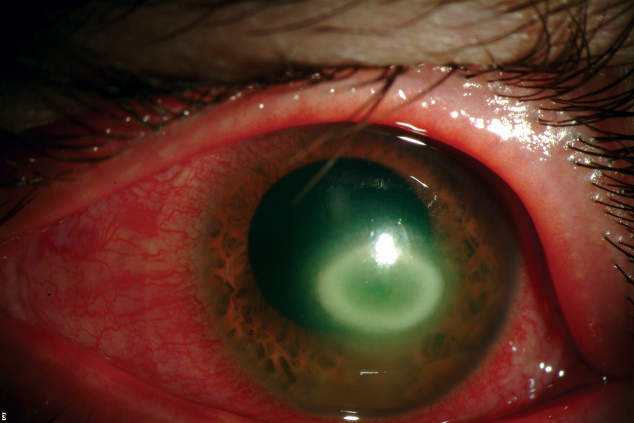 |
| Exposing contact lenses to water during handling can transfer free-living protozoa Acanthamoeba (often present in tap water). Photo: Nicole Carnt, BOptom, PhD. Click image to enlarge. |
A clean contact lens case is not something that many lens wearers can pride themselves on. However, keeping lenses in a sterile environment is essential for preventing ocular complications and infections that can result from cross-contamination. Specifically, exposing contact lenses to water during handling can transfer free-living protozoa Acanthamoeba (often present in tap water) and water-borne gram-negative microorganisms such as Pseudomonas aeruginosa to the lens storage case, causing inflammation and even threatening vision in some cases. Researchers examined associations between water contact behaviors and levels of storage case microbial bioburden and endotoxins.
A total of 165 daily soft lens wearers participated in the study (mean age=25). First, they were asked to complete a self-administered questionnaire on contact lens hygiene, which scored participants in four key areas including lens disinfection (0 to 20), hand hygiene (0 to 8), storage case hygiene (0 to 6) and storage case replacement schedule (0 to 6). Next, subjects were asked about water contact behaviors, after which a score of between 0 to 8 was calculated (0 signifying lowest risk). Lastly, the team collected contact lens storage cases from each participant and performed microbial analysis.
The largest portion of participants reported having moderate hygiene compliance (47%), followed by 35% who reported poor and 17.6% who reported excellent compliance. A quarter of participants reported occasionally leaving contacts in overnight.
As far as water exposure behaviors, about half of the participants reported having good water contact behavior while the other half reported poor behavior. A sizable 46% reported showering during lens wear, and half of all participants reported swimming while wearing their lenses in the past year (65% of whom didn’t wear goggles in the water).
High endotoxin values were found in 65 participants’ contact lens cases, which had significantly higher levels of bacterial bioburden compared with the remaining 100 cases with low endotoxin levels. The researchers attribute high contamination levels to a variety of factors.
“Wearing lenses for more than five years compared with less lens-wearing experience, using a six-monthly replacement frequency lenses compared with a monthly replacement frequency lenses, napping while wearing lenses, not rinsing the storage case at all after use compared with rinsing lens case with the disinfecting solution or saline/water and replacing a storage case longer than three months were independently associated with higher overall storage case bioburden,” the team wrote in their paper. “Interestingly, female sex, purchasing lenses online compared with purchase from a practitioner and using a storage case older than one month were independently associated with high endotoxin levels.”
Water exposure behaviors also had a major impact on the amount of contamination in study participants’ contact lens cases. “Showering, swimming and using wet hands to handle lenses were common water contact behaviors and showed a significant association with higher overall storage case bioburden and endotoxin levels,” the researchers wrote.
Contact lens cases can act as a surrogate for bacterial contamination and lead to serious infection, as proven in numerous studies previously. Teach and continuously remind your lens-wearing patients to practice proper hygiene and lens care such as washing the storage case regularly, cleansing hands before touching the lenses or case and avoiding water exposure.
Arshad M, Carnt N, Tan J, Stapleton F. Effect of water exposure on contact lens storage case contamination in soft lens wearers. Optom Vis Sci. 2021;98(9):1002-10. |

